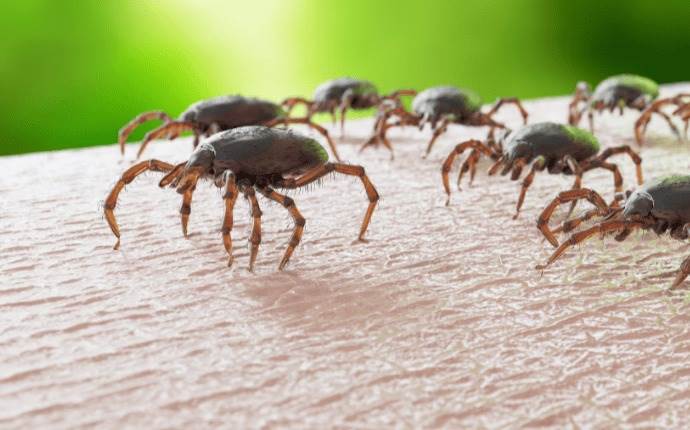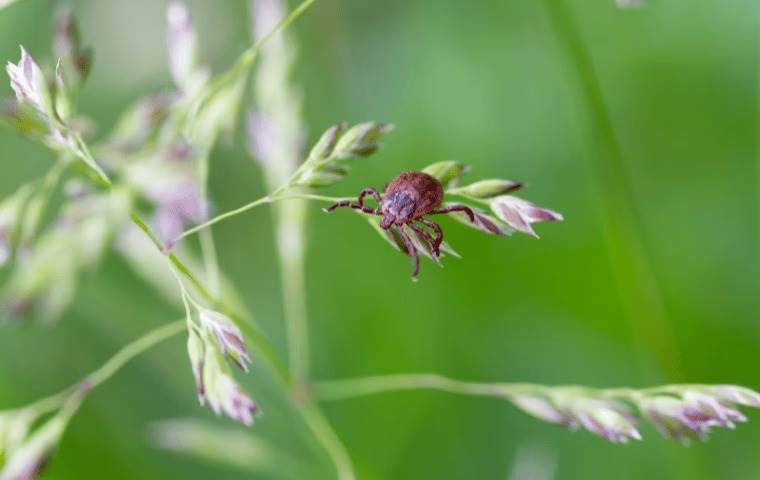
Tick Identification In Florida
When Is Tick Season In Florida?

You may know to watch out for ticks in Florida in the summer, but did you know that it actually depends on the species?
There are 5 important ticks to know about that you might find in Port St. Lucie, Fort Lauderdale, West Palm Beach, Miami, and Tallahassee:
- The Black-legged tick
- The American dog tick
- The Brown dog tick
- The Lone star tick
- The Gulf Coast tick
Each of them have their own active season, which varies on the age of the tick, so tick season is technically year-round.
But, most of them are active during spring and summer.
And to get to specifics, here’s a quick guide to “tick season” for each of the 5 major ticks:
Black Legged Tick:
- Adults: fall, winter, early
- Larvae & nymphs: spring - summer
American Dog Tick:
- Adults: spring - summer
- Larvae & nymphs: spring - summer
Brown Dog Tick:
- Adults: spring - fall
- Larvae & nymphs: spring - fall
Gulf Coast Tick:
- Adults: winter - fall
- Larvae & nymphs: winter - fall
Lone Star Tick:
- Adults: spring - summer
- Larvae & nymphs: spring - fall
The big point to take away from this info is it’s important to look out for ticks in South Florida all year - especially considering that it’s the ideal climate (warm, humid, rainy).
What Do Ticks In Florida Look Like?
Despite the common assumption, ticks aren’t insects. They’re technically teeny tiny arachnids like spiders and scorpions, and are also a mite, part of the superorder Parasitiformes.
They have 8 legs just like spiders (except as larvae they have 6). Hard ticks have a scutum on their backs. So if you’re trying to distinguish hard ticks from soft ticks, soft ticks don’t have a scutum.
They vary in size, but the important thing to know is that they’re all super small - which is why it’s important to check your body extra closely for ticks after being in an area they’re often found (wooded, forestry, or grassy areas).
They’re also usually brown, with a few exceptions. Some ticks like the lone star and the American dog have white marks on their backs.
The reason they’re able to attach themselves to hosts is because of their small size and flat bodies.
While their spines and claws help them grasp onto hosts, their mouthparts help them pierce the host and suck out the blood.
These parts help them stay stuck to the host. And as they feed, their bodies start to swell from the blood.
And fun fact: Ticks have their own version of a brain, called a synganglion, under the scutum (the shield I talked about earlier!) They also don’t have lungs, but instead have spiracles (so do cockroaches), which are like gills, that absorb oxygen.
Why Do Ticks Bite?
While it may seem like they’re just trying to catch a piggy-back ride, ticks have a parasitic relationship with humans and other animals like birds, deer, rodents, dogs and other mammals.
To stay alive, they feed on blood, and require three different “hosts” throughout their lives.
A “host” is the species they attach themselves to, to get their blood. They find their first host as larvae, second as nymphs, and third as adults.
Their search for a host is called “questing.” I’ll give an example:
Let’s say you’re a little baby tick larva ready for your first big meal in the forest. Time to go on a quest!
There are two strategies you’ll be trying to get your first host:
- The “ambush” where you’ll climb onto the rocks, extend your front legs, and wait for a host to come by to jump and attach yourself.
- The “hunter” where you find a host and pursue it until you find a way.
Sound fun?
Unfortunately, there are a few factors that might affect your quest. As a tick, you want to quest when there’s:
- High humidity
- Warm temperatures
- Rain to boost humidity
- More ticks to join
- Little to no predators
Oh look! It’s a bird - the perfect host for a larva. You decide to ambush it and now you’ve got your food.
It’s up to you how long you wanna stay on your bird. You may feed for days or even weeks.
Either way, if you have any bacteria in you, you’ll likely transfer it over within a day or two. Then, when you’re done with your host, you’ll just simply drop off the deep end and continue living your life on the ground.
Then the molting process begins, which signals the development from larva to nymph or nymph to adult - you can tell if a tick is molting if they’ve turned a white color.
Now, there’s another ending to the story, where the molting process doesn’t begin. The ending is simply: squish!
If you find a tick on your body, you’ll want to remove it asap in case the tick is infected. It takes about 24-48 hours for a tick to transmit bacteria, so that’s why you want to do a thorough check after outdoor activities like hiking or fishing.
And when you remove the tick, find a good pair of tweezers and grab the tick as close to your skin as possible, then pull straight back.
Aim for the head, not the abdomen - if punctured, you’ll be exposed to any bacteria from the tick. Avoid using other remedies like heat, vaseline or oils, which can lead to the same result.
If the size of the tick surprises you, this could mean that the tick has already been feeding for a while. A tick with a swollen belly means a tick full of blood.
In this case you’ll want to pay extra special attention to the bite and make sure nothing is out of the ordinary. If you develop a rash, fever above 102 degrees, aches, then see a doctor as soon as you can.
How To Prevent Ticks In Florida?
The best way to avoid finding any ticks on your body in the first place (but sadly not so realistic in Miami) is to wear the right protective clothing. Long sleeved shirts and pants will keep the ticks off your skin.
If you have boots, wear them with pants tucked in for more protection.
To avoid overheating in high temperatures, make sure the clothing is loose fitted and light colored.
You can use a repellent to really make sure the black-legged dog ticks, American dog ticks, lone star ticks, Gulf Coast ticks and brown dog ticks never even try to go near you, your family, or your pets.
A natural tick repellent is lemon eucalyptus oil - think of it as an eco-friendly bug spray (and yes, you can also use this on mosquitoes too!)
The only problem with this method is it’s not a long-lasting repellant, so you’ll need to reapply frequently.
How To Protect Your Pet From Ticks In Florida?

- Take care of your lawn: You may be surprised by how much this helps reduce the population of ticks in your yard. Our lawn care technicians at Native Pest Management can keep your trees, bushes, and lawn well taken care of with pet friendly products.
- Check your dogs: After you let your dogs around a place where there could be ticks around, check them carefully. There could be ticks between the toes, in the ears, around the legs or neck, and make sure you inspect deep in the fur (especially if they are a floofer).
- You’ll want to make sure you remove the tick immediately and get the entire tick off of the skin.
- Keep your dog indoors
- Of course your dog(s) should be outside periodically throughout the day for walks and playtime, but they shouldn’t be outside in a potentially infested area during tick season. If you do, just make sure you’re willing to do a thorough tick check after each time, or put them on a tick medication.
Tick Control Near Me
If you’re worried about the ticks in Florida infesting your house, or infecting you with a serious illness, we’re here to give you your peace of mind back. Native Pest Management provides professional lawn care treatments to make your home a tropical paradise.
If the ticks are inside your home, we provide home pest control treatments to eliminate them completely.
Our lawn care products are pet friendly and eco-friendly, so you’ll be protecting your family and your pets from any black-legged ticks, lone star ticks, Gulf Coast ticks, American dog ticks and Brown dog ticks that may make their way into your yard.
We provide tick control throughout Florida, in cities including West Palm Beach, Port St. Lucie, Miami, Fort Lauderdale, and Tallahassee. To learn about other locations we service, check out our service area page.
Call us for more information about our tick control options, or request your free quote today!

Why Choose Native Pest Management?
We Exceed Customer Expectations
-
Pet Friendly & Environmentally ConsciousNative Pest Management applies our pest control products with the safety of your family and pets in mind! We also offer eco-friendly pest control to protect your family and the planet.
-
Local Service ProfessionalsSince 2015, we have served communities in West Palm Beach and all throughout South Florida. Our team is fully licensed, insured, and vetted.
-
On TimeOur team will not only arrive on time, but they’ll also go above and beyond when providing service. It’s what makes us one of the top rated pest control companies in Florida! We strive for complete customer satisfaction every time.
-
Get a 100% Free Estimate
Whether you currently have pests in your home or simply want to start professional pest prevention, take the first step to a pest-free life, and contact us today for your free pet-friendly pest control quote.
-
“Warren took his time with the servicing and was very knowledgeable! Exceptional customer service. I will be requesting him each time.”- Montiea Singletary
-
“Excellent service by Chino from Native Pest Management. Chino went above and beyond to make sure we understood everything about the service and kept us very informed during the process.”- Brand Gonzalez
-
“Truly professionals at what they do. very respectful very knowledgeable and great attitude.”- Jorge Acosta
-
“I called and spoke to the manager, who was polite and courteous, and even though it cost them money to come back out and spray, they did not charge me again, and I was very thankful.”- S. Williams
-
“Dale is the absolute best in the business of pests! My sister and I personally ask for him every single time because he always goes above and beyond.”- Zariah Graham
-
“The technician was very professional. He explained things thoroughly and put me at ease with what was about to happen in my home.”- Anthony Diaz
-
“Native pest management always exceeds my expectations! The people who answer the phone are so nice and accommodating and make scheduling a breeze! The techs are always so nice and do a great job.”- Michelle Cato
-
“Extremely impressed with the technicians I met today. Tony and Jamie. Very thorough and customer oriented. I am expecting great things for my trees and plants.”- Curt Kredo

Native Pest Management's Blog
Want all the latest news or updates? Browse through our blog to read our most recent posts and featured articles.







